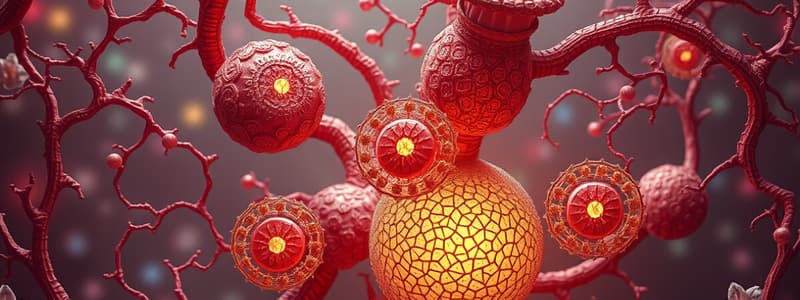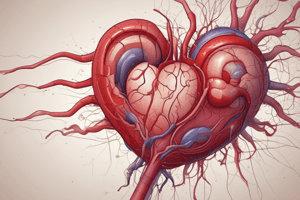Podcast
Questions and Answers
What is the difference between a thrombus, embolus, and embolism?
What is the difference between a thrombus, embolus, and embolism?
A thrombus is a blood clot that forms in an undamaged blood vessel. If the thrombus breaks loose and starts moving, it becomes an embolus. If that embolus continues to travel and reaches a blood vessel that is too small, it will get stuck and become an embolism.
What is the purpose of Virchow's triad?
What is the purpose of Virchow's triad?
Demonstrate the underlying physiology that drives the formation of a thrombus.
What are the 3 factors involved in the pathogenesis of intravascular clotting (Virchow's Triad)?
What are the 3 factors involved in the pathogenesis of intravascular clotting (Virchow's Triad)?
Slowing or stasis of blood, endothelial damage, and hypercoagulability.
What are the two types of venous thrombosis?
What are the two types of venous thrombosis?
Where do most thrombi occur?
Where do most thrombi occur?
What are the two types of thrombosis?
What are the two types of thrombosis?
What are the predisposing factors for venous thrombosis?
What are the predisposing factors for venous thrombosis?
What are the possible outcomes of venous thrombosis?
What are the possible outcomes of venous thrombosis?
Describe the damage caused by a large pulmonary embolism.
Describe the damage caused by a large pulmonary embolism.
Describe the damage caused by a small pulmonary embolism.
Describe the damage caused by a small pulmonary embolism.
What are the signs of a large pulmonary embolism?
What are the signs of a large pulmonary embolism?
What are the signs of a small pulmonary embolism?
What are the signs of a small pulmonary embolism?
How would an x-ray help you diagnose pulmonary embolism?
How would an x-ray help you diagnose pulmonary embolism?
How would a CT be helpful in diagnosing pulmonary embolism?
How would a CT be helpful in diagnosing pulmonary embolism?
How can PE be prevented?
How can PE be prevented?
What is the main cause of arterial thrombosis?
What is the main cause of arterial thrombosis?
What is gangrene?
What is gangrene?
What are intracardiac thrombi?
What are intracardiac thrombi?
What is the biggest risk with intracardiac thrombi?
What is the biggest risk with intracardiac thrombi?
What are the factors that can lead to thrombosis via increased coagulability?
What are the factors that can lead to thrombosis via increased coagulability?
Where is edema usually first found?
Where is edema usually first found?
What four factors regulate fluid flow between capillaries and interstitial tissue?
What four factors regulate fluid flow between capillaries and interstitial tissue?
How do lymphatic channels control fluid balance?
How do lymphatic channels control fluid balance?
How does capillary hydrostatic pressure affect fluid balance?
How does capillary hydrostatic pressure affect fluid balance?
What is pitting edema?
What is pitting edema?
What is pleural effusion?
What is pleural effusion?
What is ascites?
What is ascites?
What is shock?
What is shock?
What are the categories of shock?
What are the categories of shock?
What is hypovolemic shock?
What is hypovolemic shock?
What is cardiogenic shock?
What is cardiogenic shock?
How is septic shock different from anaphylactic shock?
How is septic shock different from anaphylactic shock?
What is anaphylactic shock?
What is anaphylactic shock?
What are the signs and symptoms of shock?
What are the signs and symptoms of shock?
What is the treatment for shock?
What is the treatment for shock?
Flashcards are hidden until you start studying
Study Notes
Thrombosis and Pulmonary Embolism
- Thrombus: a blood clot that develops in an intact blood vessel.
- Embolus: a thrombus that detaches and travels through the bloodstream.
- Embolism: occurs when an embolus lodges in a smaller blood vessel, blocking blood flow.
- Virchow's Triad identifies three factors for thrombus formation: blood stasis, endothelial injury, and hypercoagulability.
- Two types of venous thrombosis: deep vein thrombosis (DVT) and pulmonary embolism (PE).
- Most thrombi are located in the legs, typically leading to venous complications.
- Types of thrombosis: venous and arterial.
- Predisposing factors for venous thrombosis include prolonged bed rest, varicose veins, increased blood coagulability, and ineffective venous pumping.
- Outcomes of venous thrombosis may include leg swelling or pulmonary embolism.
Effects of Pulmonary Embolism
- A large pulmonary embolism can block major pulmonary arteries, but may not cause lung infarction due to collateral circulation.
- A small pulmonary embolism may occlude peripheral arteries, leading to lung segment infarction and necrosis.
- Signs of a large PE include dyspnea, cyanosis, shock, and potential sudden death.
- Signs of a small PE include dyspnea, pleuritic chest pain, cough, and hemoptysis.
- Chest x-ray can detect lung infarcts but not identify the presence of an embolus.
- CT scans are effective in diagnosing PE via observation of obstructed blood flow.
Prevention and Risks
- Preventive measures for PE include ambulation, compression stockings, low-dose anticoagulants, and possibly IVC filters.
- Arterial thrombosis usually results from vessel wall injury due to arteriosclerosis, leading to plaque formation.
- Gangrene refers to tissue necrosis caused by inadequate blood supply.
- Intracardiac thrombi are blood clots formed within the heart, posing risks of distal embolization affecting organs like the spleen and brain.
Fluid Management and Edema
- Increased coagulability can lead to thrombosis due to factors like hormonal contraceptives, genetic mutations, and tumor-associated thromboplastic substances.
- Edema typically first manifests in the ankles and legs.
- Four key factors regulating capillary fluid flow: capillary hydrostatic pressure, permeability, osmotic pressure, and lymphatic channels.
- Lymphatic channels play a critical role in maintaining fluid balance by removing interstitial fluid.
- Capillary hydrostatic pressure pushes fluid from capillaries into extracellular spaces.
- Pitting edema leaves an imprint when pressure is applied.
Shock
- Pleural effusion indicates fluid accumulation in the pleural cavity surrounding the lungs.
- Ascites refers to fluid accumulation in the peritoneal cavity.
- Shock is a life-threatening condition resulting from failure in the circulatory system to adequately perfuse body tissues.
- Categories of shock: hypovolemic (low blood volume), cardiogenic (inadequate heart output), septic (infection-related), and anaphylactic (allergic reaction).
- Symptoms of shock include rapid shallow breathing, cold and clammy skin, weak rapid pulse, and low blood pressure.
- Treatment includes vasodilatory medications and intravenous fluids for volume restoration.
Studying That Suits You
Use AI to generate personalized quizzes and flashcards to suit your learning preferences.



